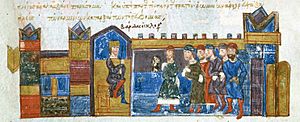Bardas Skleros facts for kids
Quick facts for kids
Bardas Skleros
|
|
|---|---|

Proclamation of Skleros as Emperor, miniature from the Madrid Skylitzes
|
|
| Native name |
Βάρδας Σκληρός
|
| Other name(s) | Sclerus |
| Died | 2 April 991 |
| Allegiance | Byzantine |
| Rank | General |
| Battles/wars | Battle of Arcadiopolis, Battle of Pankalia |
Bardas Skleros, also known as Sclerus, was a powerful general in the Byzantine Empire. He led a big rebellion against Emperor Basil II from 976 to 979. This rebellion happened in the eastern parts of the empire, in Asia.
Contents
Who was Bardas Skleros?
Bardas Skleros came from a very important family called the Skleroi. This family owned huge amounts of land in the eastern part of Asia Minor. His mother, Gregoria, was related to Emperor Basil I.
Early Military Successes
One of Bardas's greatest achievements early in his career was defending Constantinople in 970. He protected the city from the army of Svyatoslav I of Kiev. In a battle called the Battle of Arcadiopolis, his army caused many casualties to the enemy. The Byzantine army, however, lost very few soldiers.
After showing his great skill in battle, Bardas became a trusted advisor to Emperor John I Tzimiskes. John was also his brother-in-law. When John died, Bardas hoped to become the next emperor.
Why Did Bardas Rebel?
The person actually in charge of the government was a powerful official named Basil Lekapenos. He had different plans for who should rule. In 976, Basil Lekapenos removed Bardas from his important job as a general in the East.
A historian named Michael Psellos described Skleros as a very smart and wealthy man. He was good at planning and carrying out his ideas. He also had royal family connections and a history of winning big wars. Many soldiers supported him, which was very helpful for someone aiming to become emperor.
The Great Rebellion of Bardas Skleros
When Bardas Skleros heard he was removed from his position, he decided to rebel. He made agreements with local rulers in Armenia, Georgia, and even some Muslim leaders. They all promised to support him as emperor.
Bardas quickly started a rebellion among his relatives and supporters in the Asian provinces. He soon took control of important cities like Caesaria and Antioch, along with most of Asia Minor.
Battles on Land and Sea
Several commanders from the Byzantine navy joined Bardas's side. He then rushed towards Constantinople, planning to block the Dardanelles strait. The rebel navy tried to block the Dardanelles, but the Imperial Fleet defeated them.
After losing control of the sea, Bardas Skleros began to attack the city of Nicaea. Nicaea was considered a key city to reach the capital. A brave commander named Manuel Erotikos Komnenos defended the city. He was the father of a future emperor, Isaac I Komnenos.
Meanwhile, Emperor Basil II called back another general named Bardas Phokas the Younger. Phokas had rebelled before and was living in a monastery. Phokas went to Sebastea in the East, where his family lived. He made a deal with David III Kuropalates of Tao, who sent 12,000 Georgian horsemen to help Phokas.
Skleros left Nicaea and went East to fight Phokas. Skleros defeated Phokas in two battles. However, Phokas won a third battle. On March 24, 979, the two leaders fought each other directly. Skleros wounded Phokas's horse, but then Skleros himself got a serious head injury. A rumor spread that Skleros had died, and his army ran away. But Skleros was alive and found safety with his Muslim allies. After this, the rebellion was quickly stopped.
Later Life and Return
After his allies refused to help him fight Constantinople, Skleros and his family went to Baghdad in 980. They lived there for six years, hoping to invade the Byzantine Empire again.
In 987, Phokas called Skleros back to his homeland. Phokas was also trying to become emperor while the empire was busy fighting the Bulgarians. Skleros quickly gathered an army to support Phokas. However, Phokas put Skleros in prison, stopping his plans.
When Phokas died in battle in 989, Skleros became the new leader of the rebellion. A historian noted that Skleros was a very determined leader. He won the loyalty of his men by being kind and friendly. He ate and drank with them, called them by name, and made them devoted to him.
The exact date and reasons for his surrender are not fully known. In 991, Emperor Basil II visited Skleros, who was now blind and living in semi-captivity. Skleros accepted a special title and died a few days later, likely on April 2.
Skleros's Family Legacy
Bardas Skleros's family line continued. His grandson, Basil Skleros, married a sister of Emperor Romanos III. One of Basil's nieces married Constantine Monomachos, who later became emperor. Another grandniece became Constantine's mistress. One of these women was the grandmother of a famous ruler named Vladimir Monomakh.
Images for kids
See also
 In Spanish: Bardas Esclero para niños
In Spanish: Bardas Esclero para niños
- Badh ibn Dustak
Sources
- Catherine Holmes: Basil II and the Governance of Empire, 976–1025. Oxford University Press, Oxford 2005, ISBN: 0-19-927968-3.



